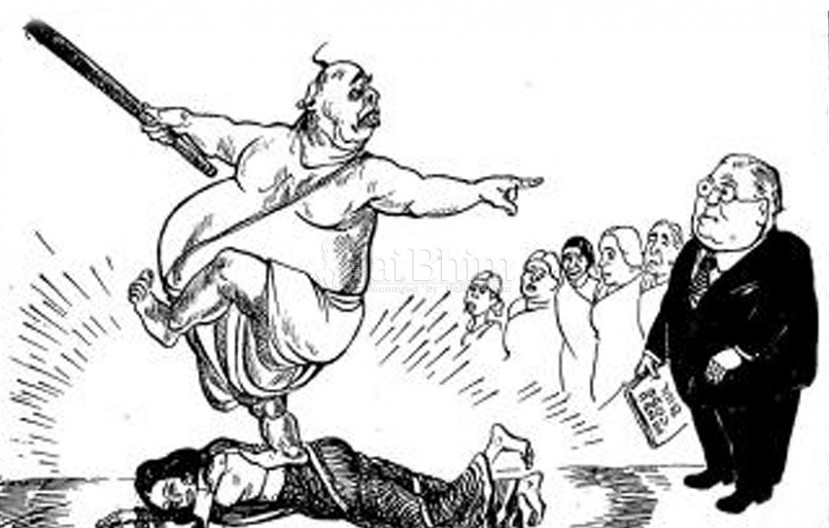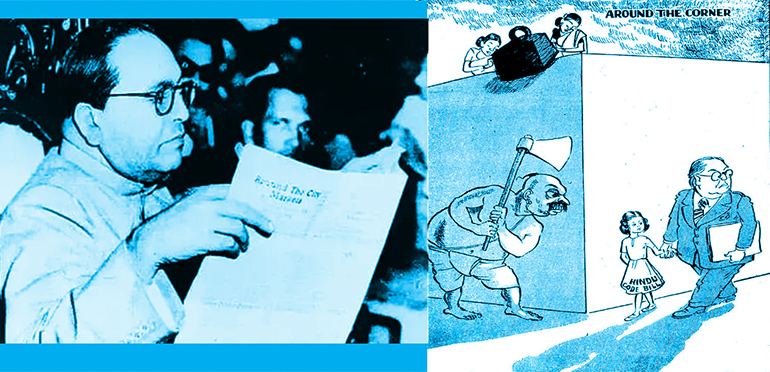[dropcap]D[/dropcap]r BR Ambedkar is best remembered for his views on Hinduism and caste, and yet his feminist ideology holds a crucial place in the history of the nation. While the term “feminism” is not new to liberal discussions, these have often not done justice to the voices of women and men of different castes and classes. Ambedkar’s struggle for equality was alert to caste and gendered discrimination. His feminism demands a pointed introspection that scrutinises privilege and questions norms within the mundane, within the home.
Ambedkar on marriage
Ambedkar originally wrote the text Castes in India (1916) for a lecture at Columbia University where he was studying at the time. While this text is primarily concerned with the caste system, it is within these discussions that the reader is introduced to the intricate links between caste and marriage in modern India. Ambedkar explained that “caste is an enclosed class” where Brahmins, while closing themselves in, closed others out. Ambedkar writes that endogamous marriage, namely, marriage within the same caste and community, is the primary reason for the perpetuation of caste. He elaborates by saying that it is through the system of imitation, blindly followed by people, whether consciously or otherwise, that this closed-door system is continued and normalised.
A closer look at our society today, over a hundred years after the publication of Castes in India, betrays the enduring significance of this discussion. Arranged marriages, the norm in India, are tightly bound within the caste of the individuals. Even young individuals who choose their own partners, whether in cities or towns, tend to self-censor their options within their own community. Some of these couples might well strive towards equality within their marriage and within their lives, and yet this feminism stands a long distance from Ambedkar’s feminism. His feminism recognises caste differentiation and discrimination that governs our lives and our decisions — who we socialise with, who we hire, where we live, and who we marry.


Photo Credit: JaiBhimOnline
As the first law minister of independent India (1947 – 1951), Ambedkar sought to introduce the Hindu Code Bill in Parliament. One of its most defining features was the right to civil marriage, that is, the right to marry in court, free of rituals, customs or religious figures. This legislation, for the first time in the history of the nation, allowed individuals to marry regardless of caste, creed or community. In other words, it allowed couples the option to subvert the influence of religion and family, if they so desired.
In addition to his radical thoughts, Ambedkar gave women the respect of addressing them directly regarding matters that concerned them. Speaking at the All-India Depressed Classes Women’s Conference (1942), he said, “Give education to your children. Instill ambitions in them… Don’t be in a hurry to marry: marriage is a liability. You should not impose it upon children unless financially they are able to meet the liabilities arising from them… Above all let each girl who marries stand up to her husband, claim to be her husband’s friend and equal, and refuse to be his slave”. What is striking here is his casual undermining of the sanctity of marriage in a society where the importance laid on the marital status of a woman is tremendous. Further, the demand of standing as an equal within marriage is an unparalleled and audacious assertion of dignity for Indian women whether amongst leadership, law or indeed, their own families.


Ramabai Ambedkar | Photo Credit: Wikipedia
While Ambedkar predates one of the most powerful feminist slogans of the 20th century “the personal is the political”, his relationship with wife Ramabai is an accurate representation of precisely this. In a touching tribute to her in Pakistan or Partition of India some years after her death, he wrote, “Inscribed to the memory of Ramu – As a token of my appreciation of her goodness of heart, her nobility of mind and her purity of character and also the cool fortitude and readiness to suffer along with me which she showed in those friendless days of want and worries which fell to our lot”.
Ramabai was born in a small village called Dabhol in Maharashtra and was married to Ambedkar at the age of nine. Interestingly, her views on religion and temple worship stood in contrast to her husband’s well-known stance on Hinduism and temple entry (he vehemently opposed it). Ramabai insisted on travelling to religious places of worship despite Ambedkar’s vexation about her decisions. In an instance of companionship despite difference, Ramabai wholeheartedly participated in Ambedkar’s unusual shraddha ceremony for his deceased father, despite her initial hesitation. Rather than offering a meal including sweets to Brahmins as is the ritual norm, Ambedkar had offered a meal comprising meat and fish to 40 Dalit students. Their relationship, founded upon friendship and debate despite disagreement, in many ways reflected Ambedkar’s feminism within the home.
Ramabai remained in poor health for several years and the couple lost children during/ post childbirth that caused them immense grief. Ambedkar followed the advice given by a doctor to avoid further pregnancies for the well being of Ramabai with affection and care. It may be argued that these personal experiences contributed to Ambedkar’s sensitivity and understanding not only of the physical pain of childbirth for women, many of whom did not have access to medical assistance, but also, the pressing need of birth control for the health of the woman.
On birth control
Birth control is considered an inherently feminist issue that allows the woman agency over her own body. However, it has a global history that is far more complex. Birth control was promoted extensively in India from the 1930s onwards; funded initially by eugenicist organisations in England (such as the London Eugenics Society), and in the 1950s onwards by international organisations in the USA (such as the Ford Foundation and the Population Council). The families targeted for the use and sale of birth control were overwhelmingly from economically and socially vulnerable backgrounds. Amongst other state and non-state actors, those who dominated this colonial discourse were the likes of Margaret Sanger, an American citizen considered the chief proponent of birth control worldwide and particularly in the Global South, as well as Raghunath Dhondo Karve, considered one of the pioneering champions of birth control in India. They unanimously agreed that large populations symbolised cultural and economic backwardness and were a threat to the development of the emerging nation.
Simultaneously, this was also the time that the freedom movement was gaining momentum and standing at the other end of the spectrum were Indian nationalists. Moving from Bankim Chandra’s chants of Vande Mataram (‘Hail to the Mother’) in Anandmath (1882) to Bipin Chandra Pal’s rendering of the nation as “Bharat Mata”, they glorified motherhood and the rearing (of sons) as symbolic of nation building.
Photo Credit: Dr. B. R. Ambedkar’s Caravan
It is in such a moment that Ambedkar spoke in a profoundly different voice from those around him. He declared in 1938 to the Bombay Legislative Assembly, “If men had to bear the pangs which women have to undergo during childbirth none of them would even consent to bear more than a single child in his life.” To me, the significance of this radical assertion is manifold. It treated women as individuals, deserving of respect, and independent from their presumed familial or national responsibilities. It gave cognizance that many women did not, and should, have control over the number of children they have to bear. It is extraordinary that Ambedkar pre-empted the fiery debate on (sexual) consent that continues to carry relevance today. That he spoke of this in the context of marital sex stands as a grim reminder of how much further we still have to go in our feminist battles.
In the same discussion, Ambedkar made another important observation. He recognised the physical suffering women underwent during childbirth, many of whom he understood had limited recourse to medical assistance and sometimes lost their life. He spoke of women, not as wives or mothers, but as individuals who may not have access to affordable healthcare. He said, “The present keen struggle of life renders timely marriage impossible for many and thus exposes them to lose their lives by the birth of children in their diseased condition or in too great numbers or in too rapid succession. Attempts at abortion, resorted to for the prevention of unwanted progeny, exact a heavy toll of female lives”. In such a manner, Ambedkar moved the discussion away from the classist and developmentalist discourse that had dominated birth control. Instead, he brought the woman’s health and well being at the very center of the conversation.
Towards this end Ambedkar sought to pass a resolution in support of government-funded birth control in the Bombay Legislative Assembly in 1938. He said, “Bombay is the gateway of India and this movement also entered this country through that very gate. It would be in the fitness of things, therefore, that it should also be nurtured in this very province… Birth control movement has afforded such an opportunity to our provincial government and it is hoped that they will not let it slip but will fully utilize it to the benefit of themselves and the people”. His resolution was defeated with 11 members voting in favour of the Bill and 52 members opposing it on grounds that it would spread immorality and cause a breakdown of the Indian family unit. Nonetheless, Ambedkar’s arguments skillfully put the onus of providing affordable medical care for all women in the nation, squarely on the state.
Feminist introspection
That feminism is essential for the dignity and equality of all individuals is undeniable. It may be agreed that there is much to be proud of about India’s syncretic history and culture and much to be grateful for about how far liberal thinkers, from Akbar to Jotiba Phule to Ismat Chugtai, have brought us. Yet there is much to criticise within our battles for equality. Most Indians, not the least liberals, rarely introspect on their own positioning or question their caste, class and community privileges. And feminism begins with the responsibility to blur the lines between “us” and “them”. As Ambedkar reminds us, it demands an understanding of the kind of choices and decisions we make. It demands that we scrutinise our claim for equality, lest we leave someone behind.


